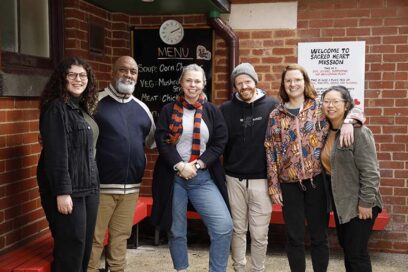Today, Monday 22, May, Sacred Heart Mission officially releases J2SI’s Baseline Research Report, which provides critical context for the program’s second phase and measurement, as well as an insight into the complexity of why 21,000 Australians are experiencing chronic homelessness.
The 60 people SHM are working with to end their cycle of homelessness through its Journey to Social Inclusion Program (J2SI), have experienced homelessness at a young age, long periods of continuous and recurring homelessness and high levels of social isolation.
Cathy Humphrey, CEO, said these findings show since the Mission’s J2SI pilot in 2009 – 2012, people deeply impacted by homelessness are still falling through the cracks of society and our service systems are not equipped to deal with these complex issues.
“J2SI tackles these complex issues through a relationship-based approach, provides long-term support, and works from the premise that if people can sustain their housing, this provides a solid foundation to the next steps of managing health issues, addressing drug and alcohol issues, building skills, becoming a part of the community and contributing to society,” Ms Humphrey said.
“J2SI’s second phase highlights SHMs continued commitment and leadership to end the issue of chronic homelessness experienced by many of the most highly disadvantaged members of our community in Victoria.
“J2SI is delivered to those experiencing high disadvantage and chronic homelessness and this report provides reassurance the right cohort was referred to the program, highlighting these people need a relationship-based approach and long-term support.”
Professor Paul Flatau, study lead, and Director of the Centre for Social Impact at The University of Western Australia said with 21,000 Australians who have no place to call home, it’s important to fully understand the critical factors at play that are contributing to their ongoing struggle.
“Only when we understand these factors – such as knowing that 91 per cent of respondents suffer from a chronic physical or mental health condition – can we interrupt the cycle of homelessness and create better outcomes by supporting their journey to improved health and wellbeing, and getting them into housing that is affordable and sustainable,” Professor Flatau said.
The data captured in this first survey showed the largest gap between the participants current and future desired situation is permanent housing, with over half saying they were optimistic about getting a house in the future.
The report also highlights parental and caregiver conflict in the family home is a significant reason why people experience homelessness. Other statistics from the Baseline Report show:
Homelessness
- Almost half (44%) of respondents say they had to leave home because of verbal and/ or physical violence
- One fifth of respondents had to leave home over 10 times and all who had to leave home due to violence were under 18 years of age when they first left, and over half were aged 10 years and under.
Physical and mental health and trauma
- Most respondents (91%) reported having a chronic physical or mental health condition
- The most common are depressive disorders (60%), substance-related abuse (56%), anxiety disorders (44%), hepatitis C (37%), chronic back or neck problems (38%), and post-traumatic stress disorder (35%)
- Three quarters of respondents were found to be experiencing high or very high levels of psychological distress, which is in stark contrast to the 10% reported for the general Australian public
- Over two-thirds of respondents screened positive for Post-Traumatic Stress Disorder (PTSD), again much higher than the 12% average for the general Australian population
Social support
- About 54% reported family never seem to understand their problems (friends: 41%)
- 54% never receive help from family they need (friends: 42%), and not surprisingly, respondents report a high level of loneliness.
Use of health services
- Frequently used health services include General Practitioner, mental health professional, emergency department and dental services
- Over one third were admitted to hospital overnight in the last 12 months with an average of 14 nights in hospital.
Alcohol and other drugs
- 87% reported using tobacco products daily or almost daily in the last three months, which is considerably more frequent than the 16% of the general
- Australian population who indicated that they smoke daily
- 18% reported daily or almost daily consumption of alcoholic beverages
- 84% reported use of substances other than tobacco and alcohol, with 59% reporting daily or almost daily use.
Other common areas of life dissatisfaction included employment and finances.
Three quarters of respondents were optimistic about achieving good outcomes in their capacity for independence and safe use of alcohol and other drugs.
Sacred Heart Mission is currently undertaking the second phase of our Journey to Social Inclusion (J2SI) program. This follows the pilot which ran from 2009 – 2012, more info here.
The Baseline Report is the first of many reports anticipated as part of J2SI phase two. Download the baseline report here.
CONTACT
Holly Cooper
Communication and Advocacy Manager
Email: hcooper@sacredheartmission.org
Phone: 0424 137 763













